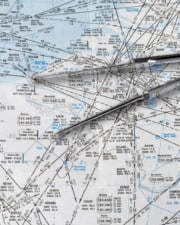Learning to fly in instrument conditions is almost as challenging as learning all of the rules and regulations that go with it. In many ways, getting an instrument rating is similar to earning your private pilot certificate. There is a slew of new terms and phraseology to master and new mechanics of operating an aircraft to master, one being IMC.
Table of Contents
IMC is defined as instrument meteorological conditions. It is the opposite of VMC or visual meteorological conditions, so it is another way of saying that the weather is not good enough to fly visually. The weather is IMC if the cloud bases are lower than 1,000 feet above the ground or if the visibility is less than three miles. But that isn’t the whole story.
The Basics: IMC & VMC
All flight operations fall into two categories, which are visual flight rules (VFR) and instrument flight rules (IFR). The two types of flights look drastically different from one another.
Visual flight rules operations must be conducted in visual meteorological conditions or VMC. Anything less than VMC is considered instrument meteorological conditions (IMC) and requires that the flight be operated under IFR.
Visual Flight Rules
Visual flight rules are the set of regulations that a pilot must follow to fly on their own, without assistance from air traffic control. They are responsible for seeing and avoiding all other aircraft. They are usually not required to contact any controller unless entering an area of controlled airspace near an airport (Class B, C, or D airspace).
This is how most pilots begin their flying careers. The private pilot course teaches them to fly visually and to operate in VMC safely. To fly in IMC, they must possess an instrument rating, and be in an instrument-approved aircraft. The instrument rating is usually the second course a pilot takes, especially if they are pursuing a professional career path.
Limits are placed on VFR flights. They cannot operate above FL180, or about 18,000 feet MSL. They must maintain enough flight visibility that they can see the horizon and operate safely using visual references. Conditions that are good enough for VFR flight are generally known as VMC. VFR pilots are required to stay a safe distance from clouds since there could be an unseen IFR aircraft operating within.
Instrument Flight Rules
Most pilots think of IMC as time spent “in the soup,” or inside of clouds or fog, but the truth is a little more complicated than that. Since IMC is defined as weather that is below visual minimums, the only way to explain it precisely is to determine what the VFR minimums are in a given airspace. When the weather is worse than that, it’s IMC.

Many controlled airspaces set the minimum VFR flight visibility to be three statute miles, and pilots must maintain 500 feet below, 1000 feet above, and 2000 feet horizontal separation from clouds. The actual rules vary from one type of airspace to another, and beginning pilots learn the specifics of everywhere they will operate.
In some places, like busy Class B airspace, pilots are allowed to get closer to clouds since all aircraft are receiving radar separation. In other areas, like above 10,000 feet MSL, pilots must maintain greater visibility (five miles) and farther from clouds since, at this altitude, aircraft move much faster. More warning and reaction time is required for see-and-avoid collision avoidance to work.
For a complete list of the VFR weather minimums, see to 14 CFR §91.155.
Weather Reports and Forecasts
Before a pilot can determine if they can operate as a VFR flight, they need to research what sorts of weather they can expect along their route of flight. Aviation weather charts clearly show where instrument conditions are likely to happen since this is one of the most basic weather problems that pilots encounter.
Somewhat unrelated to the operation of the aircraft, weather reports and charts have their own set of definitions of what constitutes VFR and IFR conditions. They even add more categories that do not exist in the regulations but are helpful when analyzing the weather along your route. Those are low IFR and marginal VFR conditions.
Weather reports are standardized in the following ways.
- VFR, or visual flight rules, exists when the visibility is above five miles, and/or the ceilings above 3,000 feet AGL.
- MVFR, or marginal VFR, exists when the visibility is between three and five miles, and/or the ceilings are between 1,000 and 3,000 feet AGL.
- IFR, or instrument flight rules, exists when the visibility is below three miles, and/or ceilings are less than 1,000 feet AGL.
- LIFR, or low IFR, indicates visibility is below one mile and/or ceilings are less than 500 feet AGL.
It’s important to understand that these categories appear for the purpose of categorizing an airport’s weather. They do not necessarily mean that a pilot would be able to operate in VFR conditions while meeting all of the other regulatory requirements.
For example, if a Class D airport is reporting marginal VFR conditions (MVFR) because of overcast clouds at 1,200 feet AGL, a pilot will not be able to operate in a standard 1,000-foot AGL airport traffic pattern without breaking the “500-feet below the clouds” rule. So while the field is not categorized as IFR, VFR flight is not necessarily possible for every pilot.
What IMC Means to IFR Pilots
Much of this might seem abstract to the VFR-only private pilot. Pilots must diligently learn the minimum visibility and cloud clearance requirements, and then very carefully check the weather to ensure that they can operate legally. But what does it all mean to an instrument pilot?
The answer is not very much. Most IFR flights choose to operate as such from the moment they lift off until their wheels touch down again. They are under constant control and receive separation services the entire time. They fly the courses and headings that are assigned to them, and they pop in and out of clouds along the way.

There are only a few times when an instrument pilot needs to think about the weather and confirm that it is above the VFR minimums. One of those times is when a pilot wants to cancel their IFR flight plans and thereby terminate their separation services with air traffic control. The pilot can only do that if they are in VMC.
There are also some special circumstances when the pilot must know that they are in VFR conditions. For example, some pilots like to use a VFR-on-top clearance, which enables them to fly IFR through the bad weather, and then operate as a VFR flight above the clouds.
When it comes to landing after an instrument flight, pilots flying instrument approach procedures follow what the minimums are on that approach. If the weather is below those minimums, they cannot land.
It’s worth noting that air traffic controllers, especially Approach (TRACON) and Center (ARTCC) controllers, cannot tell where IMC conditions exist. Their scopes show some areas of precipitation, but not clouds and restrictions to visibility. Often a controller may make a traffic call or indicate that a pilot is preparing for a visual approach to an airport. If the pilot is in the clouds, the proper response is that the flight “is IMC at the moment.”
Continued VFR into IMC
A recurring cause of accidents in aviation results from pilots attempting to operate visually in IMC. Some of these accidents happen to low-time VFR-only pilots who stray into weather that they should not. But a surprising number of them happen when experienced pilots push the limits too much.
Scud running is an expression that describes the act of trying to squeeze into an airport or through a mountain pass even as the weather is deteriorating. A scud running pilot is trying to complete their flight as if it is a mission and failing to realize the changing reality around them. They continue to decrease their altitude as the cloud bases, and visibility gets lower and lower until they are below safe IFR altitudes.
To help prevent accidents, the FAA has changed pilot training programs over the years. For one thing, all private pilot students get a brief introduction to operating the aircraft in IMC. The hope is that this limited amount of training and exposure will enable them to make a 180-degree turn out of dangerous IMC to return safely to VFR flight.
Additionally, there is now more focus on maintaining situational awareness, one of the soft skills of piloting an aircraft. Situation awareness is simply the act of being mentally present and noticing changes as your flight progresses. If the weather begins to deteriorate, seeing it and taking early action affects the flight’s outcome for the better. You can always change your destination, or if instrument-rated, get a pop-up IFR clearance to continue to your destination safely.
For more information on the dangers and causes of continued VFR flight into IMC, check out this analysis by Flying magazine.
Related Posts












